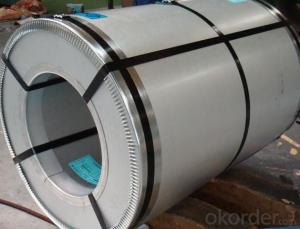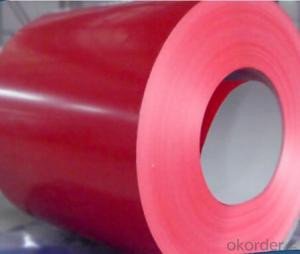Zinc Coated Gi Galvanized Steel Coil for Building
- Loading Port:
- Shanghai
- Payment Terms:
- TT OR LC
- Min Order Qty:
- 25 m.t.
- Supply Capability:
- 10000 m.t./month
OKorder Service Pledge
OKorder Financial Service
You Might Also Like
Basic Info.
Model NO.:roofing sheet
Surface Treatment:Galvanized
Technique:Cold Rolled
Standard:ASTM, JIS, GB, AISI, DIN, BS, GOST
Steel Grade:Q235
Grade:Dx51d / Dx52d/ Dx53D/ S250,280,320gd
Width:914, 1000, 1200, 1219, 1220, 1250
Base Material:Galvanized or Gavalume, Steel
Thickness:0.14mm to 1.5mm
Zinc Coating:40-150GSM
Length:up to The Thickness
Lacquer:Top Side15-25 Micro,Back Side 5 Micro
Surface:Passivation Unoiled Free Spangle Passivated
Export Markets:Global
Additional Info.
Trademark:STW or OEM
Packing:Export Seaworthy Packing
Standard:According to Your Requirement
Production Capacity:20000 Metric Tons/Month
Product Description
Specifications;
1. Aluzinc coating mass: 30g-275g/sqm
2. Coil weight:4-6 tons per coil
3. Edge treatment: Mill edge or cut edge.
4. Technical treatment: Bright annealed, flatting, cold harden.
5. Surface treatment: Annealed, bright finish, dull/bright finish, slit edge.
6. Spangle: Normal/small/big/zero spangle.
7. Delivery terms: FOB / C&R / CIF
8. Supply Ability: 30000MT/month
9. Application: The construction industry: The roof structure, keel, grill, Clapboard, ceilings, fire shutter doors, etc; The light industry, the Automobile, agriculture, animal husbandry, fishery, casing of household Electronic application, civilian smoke stack, etc.
10. Delivery time: Within 30 days after the receipt of L/C or Signed the contract or according to customer's requirement.
Special design available according to requirement; Anti-corrosion And high-temperature resistant with black painting; All the production process Are made under the ISO9001: 2000 strictly
| MOQ | 50MT |
| What knid of color we can offer | RAL not only RAL, we can provide the color according to customer' s sample |
| What is the paint? | PE, PVDF |
| What is the original material for color-coated coil? Galvanized steel coil/cold rolled coill? | PPGI(raw material GI), GI(raw material CRC) CRC( raw material HRC) |
| Surface | Regular/mini/zero spangle, chromated, skin pass, dry etc. |
| Coil Inner Diameter | 508mm |
| Strength of material ? | G550= 550 mpa, normally around 280 mpa |
| what is the range of width we can do | 750mm, 762mm, 914mm, 1000mm, 1200mm, 1219mm, 1220mm, 1250mm |
| Thickness of the zinc coating | Z40 to Z275 |
| which color is most popular? | Blue in China, brown, red, green in oversea market |
| The weight of each coils? | Normally 5Tons. We can customized 3-6Tons |
| What is the leadtime? | Normally for coils we can delivery it within 25-30 days. Depends on the quantity |
| How many years of the paint would be lasting? | Different zinc, paint coating would lead to different result, and the environment has great impact on the life time of painting. |
| Applications | With excellent cold bending molded manufacturablity, good decoration effect, strong anti-corrosion ability, galvanized steel coils and sheets are also pollution-free and easily recycled. Accordingly, they can be used as final products and basic plates of color coated steel coils and widely applied in construction, home appliances, decoration, ect. |
- Q:also what are the factors of location of these steel plants
- I work for a pipe manufacturer in Birmingham, AL. We have multiple divisions including two specialized steel pipe divisions and a ductile iron pipe divisions. As far as the steel pipe divisions, they purchase skelp from suppliers. All of the steel that they purchase is of domestic manufacture, and is very expensive. As for the ductile iron division, we manufacture our own iron for the pipe. To get the iron that we need, we buy scrap in the form of cars, refrigerators, rejected pipe that we produce, etc. It is shredded in one part of the plant, and then melted and cast as a new product. This has become very problematic, scrap prices have skyrocketed in the US due to the large demand from countries such as China who gobble all of the material because they need great quantities of it. So, to answer your question, we get steel from recycling and then some raw iron ore. As to where we get the raw ore, I'm not 100% sure.
- Q:Can steel coils be cut?
- Yes, steel coils can be cut.
- Q:benchmade mpr with m390 steel knife. Is it better than d2 s30v or 154cm steel?
- From what I understand m390 is a new steel (at least for benchmade) so there doesn't seem to be a consensus on how it performs. Looking at the table, it should be very corrosion resistant. I'd guess it could be classified as a stainless steel. Sorry I don't have more info for you. EDIT: here's a link from the steel manufacturer. I hope this info helps.
- Q:How are steel coils used in the production of pipes and tubes?
- Steel coils are used in the production of pipes and tubes by being fed into a pipe or tube mill, where they are unraveled, formed, and welded together to create the desired size and shape of the pipe or tube.
- Q:How do steel coils contribute to the energy infrastructure sector?
- Steel coils play a vital role in the energy infrastructure sector by providing the necessary materials for the construction and maintenance of various energy-related structures and equipment. Firstly, steel coils are widely used in the production of pipelines, which are the lifelines of the energy industry. These pipelines transport oil, natural gas, and other energy resources over long distances, ensuring a steady supply to power plants and other energy facilities. Steel coils are used to manufacture seamless and welded pipes that possess high strength, durability, and resistance to corrosion, making them suitable for handling the harsh conditions of energy transportation. In addition to pipelines, steel coils are used in the production of storage tanks for oil, natural gas, and other fuels. These tanks are crucial for storing large quantities of energy resources, ensuring a continuous supply even during periods of high demand. Steel coils are utilized to fabricate the tank shells, providing the necessary strength and structural integrity to withstand the pressure and environmental factors associated with energy storage. Furthermore, steel coils are instrumental in the construction of power plants and other energy infrastructure facilities. They are used to manufacture structural components such as beams, columns, and supports, which provide the foundation and stability required for the safe operation of these facilities. Steel coils also contribute to the production of equipment such as turbines, generators, and transformers, which are essential for converting energy into usable forms and distributing it to end-users. Moreover, steel coils are utilized in the construction of transmission towers and electrical grids. These structures and networks are responsible for transmitting electricity from power plants to residential, commercial, and industrial consumers. Steel coils are used to manufacture the towers and poles that support high-voltage transmission lines, ensuring their stability and reliability in transmitting electricity over long distances. In summary, steel coils are indispensable in the energy infrastructure sector as they provide the necessary materials for the construction, maintenance, and operation of pipelines, storage tanks, power plants, transmission towers, and electrical grids. Their strength, durability, and resistance to corrosion make them an ideal choice for withstanding the demanding conditions of the energy industry, thereby ensuring a reliable and efficient energy supply to meet the growing needs of society.
- Q:is there a type of steel that is stronger or does the rail represent the top of the line?
- No, train tracks are not made of the strongest steel. Actually, I believe they are made from a rather mild steel, maybe a high-carbon steel in the curves, but no means is this top of the line. Probably the best all around high strength steel, if you count hardness, tensile strength, shear, and yield is Eglin steel. It has a yield of about 245,000 psi an ultimate strength of around 293,000 psi a harness of 45.6 and an impact of about 75 joules. It's cheaper than exotic alloys, you can build aircraft with the stuff because weight isn't an issue and it's plenty strong enough. Its also very strong even in extreme temperatures. The material has a wide range of other applications, from missile parts and tank bodies to machine parts.
- Q:why does steel have a density range when other metals do not?
- Steel is not a pure element it is an alloy. Steel is primarily iron but it has many elements blended in that change it's density including carbon,silicon, nickel, chrome, etc. Aluminum and copper , magnesium and so forth can be the pure element or they can be alloys too. If they are alloys, then their densities vary also
- Q:I have some steel wool and a charged 9V Battery, when I connect 2 wires to the battery, then touch the wool with the ends of the wires the wool instantly starts burning, but when I connect 2 wires to the piece of steel wool (a new piece not same one of course) and touch the battery with the ends of the wire nothing happens (see image...)
- Steel Wool 9v Battery
- Q:What are the different methods of pickling steel coils?
- There are several methods of pickling steel coils, including the use of acid pickling baths, electrolytic pickling, and pickle lines. Acid pickling baths involve immersing the steel coils in a bath of acid solution, such as hydrochloric or sulfuric acid, to remove scale and impurities from the surface. Electrolytic pickling uses an electric current to remove the scale from the steel coils, while pickle lines involve passing the coils through a series of acid baths and rinses to clean and prepare the surface for further processing.
- Q:why do you need to heat steel when hardening, molecules etc etc
- Gary is right, but maybe I can simplify it. It's very complex..... When you heat (hardenable) steel the carbon and iron form crystalline structures. Martensite and Austenite are most prominent, but there are others. Those are the hard crystals. When you quench it, those structures don't have time to dissolve as they would with slow cooling, so you freeze the crystalline structure in that state. Since that is too hard for most things, you temper it. Heating to a certain temp lets ~some~ of the crystals dissolve away. Annealing is heating and letting it cool slowly, so those structures will break up back into carbon and iron, leaving the steel soft. It's like a little atomic machine - crystals form, dissolve away, form again, with heat. It's waaaaay deeper than just that in detail, but that's the gist of it.
1. Manufacturer Overview |
|
|---|---|
| Location | |
| Year Established | |
| Annual Output Value | |
| Main Markets | |
| Company Certifications | |
2. Manufacturer Certificates |
|
|---|---|
| a) Certification Name | |
| Range | |
| Reference | |
| Validity Period | |
3. Manufacturer Capability |
|
|---|---|
| a)Trade Capacity | |
| Nearest Port | |
| Export Percentage | |
| No.of Employees in Trade Department | |
| Language Spoken: | |
| b)Factory Information | |
| Factory Size: | |
| No. of Production Lines | |
| Contract Manufacturing | |
| Product Price Range | |
Send your message to us
Zinc Coated Gi Galvanized Steel Coil for Building
- Loading Port:
- Shanghai
- Payment Terms:
- TT OR LC
- Min Order Qty:
- 25 m.t.
- Supply Capability:
- 10000 m.t./month
OKorder Service Pledge
OKorder Financial Service
Similar products
New products
Hot products
Related keywords



























